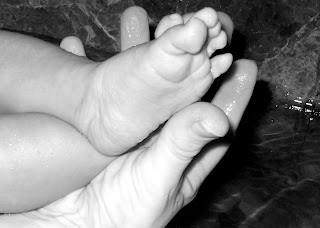
Tiny footprints are great. Our family scrapbook contains the tiny footprints of our two daughters. Liefe’s are the smallest with tiny newborn footprints done just hours after her birth. Haydee’s are a tad bigger as they were done a few hours once she came home to Maine at nine-months old. These images reinforce how both how much they’ve grown and how small they still are. Their tiny footprints remind me of my parental responsibilities to raise them well and to tread as lightly as I can on their earth so they can fulfill their obligation to leave the world a more beautiful place.
There are many tools to help us tread lightly on the earth. One is a calculator to compute individual and household carbon footprints - the annual carbon emissions created by daily living. Climate change is caused by excessive greenhouse gases such as carbon dioxide (CO2) in our atmosphere. An online search produces several such calculators. The Nature Conservancy’s carbon calculator gives clear definitions for often misused terms such as global warming and climate change. It depicts one’s carbon footprint relative to others, helping to put a household’s consumption into perspective. For example, for a household of four, the American average is 110 tons of CO2 annually, the world average is 22, and our family comes in with 44. By mainstream American standards, we’re doing well. Since climate change impacts the entire planet, we could and should be doing more.
Here are some ideas which, if you’re not already doing, will easily reduce your family’s carbon footprint. These can all be done with children. By modeling responsible consumption, we help our children shape the footprint of tomorrow. If you have other ideas, please do share them with me and others.
(1) Use cloth napkins on a regular basis. Cloth serves as a better barrier than paper so you’ll probably only need one per person for each meal. Laundered in cold water, along with the other laundry and hung to dry whenever possible, cloth napkins are better for the environment than their paper counterparts. Napkins can be purchased locally or, if you sew, will sew up quickly and can be made of any washable fabric.
(2) Make every effort to limit the amount of time your car sits idling. In other words, when you’re not using your car, turn it off. For most vehicles, you waste more gas idling for one minute than you do by turning off and restarting your car. So, if you’re going to run in to pick up your children from school, please turn off your car. Or, if you’re the the first car to get stuck in construction traffic and you know you’re going to be sitting there several minutes, turn off your car. An idling car gets zero miles per gallon. The larger the vehicle, the more gas is wasted when idling.
(3) Buy from area farmers and at farmers markets. Supermarket food travels an average of 1,300 miles from farm to table. In addition to helping the environment, you’ll get better tasting foods if you buy things grown or raised close to home. Local food is fresher because its journey is shorter than food shipped from away. Purchasing locally, or growing your own, will cost less and will keep more money in the community’s economy. The Rockland Farmers market is at the Public Landing on Thursdays, 9 a.m. -1 p.m. The Camden Farmers market is on Colcord Avenue, Wednesdays 4:30 p.m. -6:00 p.m. and Saturdays 9 a.m. -noon. Local food is also available at many farm stands as well as at The Good Tern Food Co-op, 750 Main Street in Rockland.

No comments:
Post a Comment